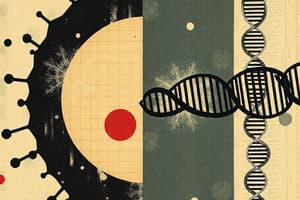Podcast
Questions and Answers
Which types of bonds are formed when there is a significant difference in electronegativity between two atoms?
Which types of bonds are formed when there is a significant difference in electronegativity between two atoms?
- Nonpolar covalent bonds
- Polar covalent bonds
- Metallic bonds
- Ionic bonds (correct)
Which factors determine if a molecule is hydrophobic or hydrophilic?
Which factors determine if a molecule is hydrophobic or hydrophilic?
- The presence of ionic bonds in the molecule
- The number of hydrogen bonds it can form
- The balance between polar and nonpolar regions (correct)
- The molecular weight of the compound
What type of bond exists between the hydrogen and oxygen atoms in a water molecule?
What type of bond exists between the hydrogen and oxygen atoms in a water molecule?
- Nonpolar covalent bond
- Hydrogen bond
- Ionic bond
- Polar covalent bond (correct)
Which class of macromolecules includes monomers such as amino acids and can form proteins?
Which class of macromolecules includes monomers such as amino acids and can form proteins?
Which type of interaction occurs between water molecules due to their polar nature?
Which type of interaction occurs between water molecules due to their polar nature?
Flashcards are hidden until you start studying
Study Notes
Common Elements in Cells
- Cells primarily consist of four main elements: carbon (C), hydrogen (H), oxygen (O), and nitrogen (N).
- Other important elements include phosphorus (P) and sulfur (S), which play crucial roles in biological molecules.
Four Classes of Macromolecules
- Proteins: Made up of amino acids (monomers).
- Nucleic Acids: Composed of nucleotides (monomers).
- Carbohydrates: Formed from sugars (monomers).
- Lipids: Generally consist of fatty acids and glycerol (monomers), though not true polymers.
Electronegativity
- Defined as the ability of an atom to attract electrons in a bond.
- Bonds can be classified based on the difference in electronegativity values:
- Nonpolar Covalent Bonds: Electronegativity difference of 0 to 0.4 (equal sharing of electrons).
- Polar Covalent Bonds: Electronegativity difference of 0.4 to 1.7 (unequal sharing of electrons).
- Ionic Bonds: Electronegativity difference greater than 1.7 (transfer of electrons).
Behavior of Molecules in Water
- Primarily Nonpolar Covalent: Tend to be hydrophobic, do not mix well with water due to lack of charge or polarity.
- Primarily Polar Covalent: Generally hydrophilic, interact favorably with water because of partial charges, forming hydrogen bonds.
Hydrophobic vs. Hydrophilic Molecules
- Hydrophobic Molecules: Typically contain nonpolar covalent bonds, lack affinity for water (e.g., fats and oils).
- Hydrophilic Molecules: Have polar or ionic bonds, interact well with water (e.g., carbohydrates and some proteins).
Water Molecule Representation
- A water molecule (H₂O) consists of two hydrogen atoms covalently bonded to one oxygen atom.
- The bond between H and O is polar covalent due to the electronegativity difference.
- Water molecules engage in hydrogen bonding with one another, leading to its unique properties.
Types of Chemical Bonds
- Covalent Bonds: Formed by the sharing of electrons between atoms, strong and stable.
- Ionic Bonds: Result from the transfer of electrons from one atom to another, leading to attraction between charged ions.
- Hydrogen Bonds: Weak attractions between partially charged hydrogen atoms and electronegative atoms (like oxygen or nitrogen).
Phospholipid Structure
- Composed of a hydrophilic (polar) head and two hydrophobic (nonpolar) tails.
- The polar head interacts with water while the nonpolar tails avoid water, forming bilayers in cell membranes.
Studying That Suits You
Use AI to generate personalized quizzes and flashcards to suit your learning preferences.




